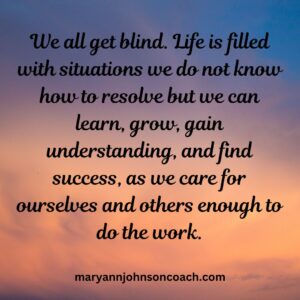 Early this spring Jodie was taking a short trip. She hauled the suitcase out of the garage so she could pack. Later, she asked me if I had seen it. No, I hadn’t but I went upstairs to help her look. We searched everywhere and then lo and behold we saw it! It was leaning up against the wall by the front door, in direct sight. It wasn’t hidden by anything. We weren’t looking for the obvious, I guess.
Early this spring Jodie was taking a short trip. She hauled the suitcase out of the garage so she could pack. Later, she asked me if I had seen it. No, I hadn’t but I went upstairs to help her look. We searched everywhere and then lo and behold we saw it! It was leaning up against the wall by the front door, in direct sight. It wasn’t hidden by anything. We weren’t looking for the obvious, I guess.
Later, I dropped a package of bread I was getting out of the freezer. I finished getting what I needed and then looked for the bread. It wasn’t on top of the chest freezer or the workbench, which is next to the stand-up freezer. I looked high and low. It couldn’t be high, but I couldn’t find it and was trying to cover all the bases. I went out to the freezer a few hours later to get something and there was the loaf of bread. It had been behind me the whole time! Sometimes you get blind!
I’ve talked about this in the past, concerning weeding, a simple thing that can cause so much personal frustration. There you are, on your hands and knees or walking down a row with the hoe. You are positive you got every weed. But as you walk back to where you began you see a stray weed here and there. What! How does that happen? Sometimes you get blind!
This type of blindness happens when we’re working on relationships, teaching our children, managing our home, figuring out how to use time more wisely, getting better systems in place so life flows more smoothly, using money wisely, healing ourselves, etc.
Experience has taught me that no matter how invested we are, we can’t always see what is right in front of us. Sometimes we are blind. There are reasons for this: preconceived ideas, weariness, our bucket is empty, feeling that the issue is too big, maybe we aren’t smart enough, we lack helpful resources, and others.
I have also learned that if we stay calm, and don’t get upset with ourselves because we can’t always see the solution, we will have a better outcome as we troubleshoot. The temptation is to be frustrated or angry with ourselves or others.
A more effective way to approach whatever is causing an issue is to make it a matter of careful thought and prayer, and then seek needed information for greater understanding. When we choose to remain calm, give ourselves grace, and move forward one step at a time, we can usually begin to see what we couldn’t see before. But blessed are your eyes, for they see…Matthew 13: 16
When we have a challenge with a child, a relationship, our home management, ourselves, etc., and are looking for a solution there are things we can do to see more clearly, to get more focus and greater light. Begin by being aware of what keeps you blind, making it difficult to see solutions.
Here are 8 tips for greater daily awareness to see more clearly.
1. Be in a good place yourself. How does a busy parent do that? Here are ways I keep myself in a good place so that when faced with a challenge I can think more clearly and find solutions.
a. Set an intention for the day – What helps me to be in a better place when I wake up each morning is to have a plan, an intention, for why I am getting up. How will I begin the day? Do you have a morning routine? I do and it helps.
b. Eat right – Don’t eat the crust of your child’s sandwich because you are on the run. Sit down. Put your food on a plate. Rest as you chew. This is something I have had to force myself to do but it pays dividends. Think carefully about what you want to fuel your body with. I know from experience that when we take control of how, when, and what we eat, we manage better.
c. Sleep – I have had so much experience with this one thing! When I took control of how and when I slept, my world changed forever. If sleep is a problem, please read how I learned to take control. It will change your life.
d. Practice self-care – I have had people tell me that a shower is a necessity not self-care, but I know it can be self-care This has kept me going for over five decades. Find what works for you, that can be done daily, right where you are.
e. Seek what you need – We don’t know everything. We can’t, so there will be issues we’re not prepared to resolve. However, if you take the time to look for resources: people, classes, books, etc. you can find what will give you the first step you need. Then you look for the second step. Seek what you need, a step at a time, and don’t fret that you don’t know how to fix everything now.
2. Take responsibility for your part. Seth, my son in his fifties, and I had a falling out the other day. Ugh. I thought about it and determined to discover my part in the problem. I mean it was easy to see where he goofed. : ) After some thought it was clear. Then I pondered how best to move forward. We cleared the air a short time later. I apologized for my part, and we carried on.
Blame is always a problem and should be avoided at all costs. It prevents clear vision, eyes that see!
3. Define the issue. Get clear on what you are trying to do, improve, or fix. Keep asking “Why?” until you get to the root. Then you will be better able to make a plan to move forward.
4. Brainstorm potential solutions. I pray and ponder. What comes readily to mind? Where could you begin? What are other possibilities? Don’t make the sucker’s choice and pick what seems the only solution but feels wrong. There is always a third, fourth, or fifth possibility. I have put this to the test! Here is a video I made about avoiding the sucker’s choice and finding workable solutions.
5. Have empathy for others and yourself. Here is the definition of empathy – ‘the ability to understand and share the feelings of another.’ Empathy is the capacity to take another perspective, but more than that, it is truly caring about the person and how they feel. When you show empathy, your feelings soften and solutions come more readily.
6. Have a plan to move forward. What is the first step? In my situation with my son Seth, the first step was to go inside myself and find my part. Because he is a private person, my second step was to find a way to say I was sorry. The third step was to pray and ask for the best possible moment. It was provided when I went outside and he was working by my shed. I calmly walked up, put my hand on his shoulder, and said, “I’m sorry.” He smiled and replied, “Me too.” That was it. It was done.
7. Evaluate as you go. Not everything is as simple as resolving the situation with my son. Some things take time. As you move forward it is helpful to ask yourself questions. Is the direction working? Do I need to rethink and begin again? Am I making progress, even a small amount? If I need to change course what is another option?
8. Allow time. It takes what it takes. When I first began learning to resolve my anger issues it took ten years. I had to allow that time and not become discouraged with myself. It wasn’t always easy, but because I persevered, I made it! Now I find myself in a similar situation. As a caregiver, with lots of stress, my tone needs work. Ugh. Seven years and I am still working on it. Am I making any progress? A little and I hold out hope for even greater progress.
We all get blind. Life is filled with situations we do not know how to resolve but we can learn, grow, gain understanding, and find success, as we care for ourselves and others enough to do the work.







